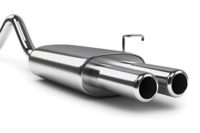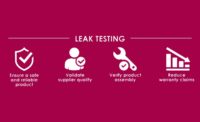Leak testing plays an important role in today’s manufacturing environment by ensuring the quality and performance of a product. A critical portion of the leak testing process is sealing the part for pressure or vacuum testing; however, this step is given little attention. And all too often, this is the Achilles’ heel of a poorly conceived leak test process.
Historically, manufacturers relied on wrenching and sealants or the use of jury-rigged clamping fixtures to seal a thread, a tube or a cavity. This is an inefficient, time-consuming process that may damage the product. While this damage may not be immediately evident, it could stress the part that may cause leaks down the road when it is put into customers’ use. Additionally, there are ergonomic concerns with wrenching or other manual clamping associated with this process.
While there are many sealing misconceptions, this article will focus on three common misconceptions or methods that result with a poor sealing practice, identify the issues associated with the practice, and recommend a better method of sealing.
Misconception #1: Sealing a threaded port or fitting. “I’ll just use pipe dope.”
For taper threads, commonly known as NPT or BSPT, using a thread sealant is the proper method to make the connection when installing the product for final use. These threads are common in the appliance, plumbing, compressed air and low-pressure hydraulics. The misconception is that using a common taper fitting and thread sealant (they call it pipe dope for a reason) is a good method (practice) to seal the port for a leak or pressure test. On the positive side, this is how these threads are designed to mate and create a leak tight connection. On the negative side, this creates three issues:
- To make the seal, the mating threads must be torqued tight, thus crushing the threads against one another. This condition deforms the thread, causing the thread to gauge differently than when it was newly machined. This creates a used part!
- Thread sealant must be used as a lubricant to reduce galling and as a sealing agent to eliminate spiral leakage. Sealant removal and cleaning the threads is messy and time consuming.
- Ergonomic concerns. Wrenching and torqueing a fitting tight in a production environment can cause severe operator stress leading to worker compensation.
Alternatively, a better method is to apply one of several manual sealing devices on the market that are easily twisted or instantly connected to a threaded port or fitting with no wrench tightening or thread sealants. These products greatly improve the testing process, significantly reduce ergonomic issues associated with wrench tightening a fitting and leave the product in new condition. The features that make these products function include:
- The connectors are not torqued tight into the port, thus there is no thread damage.
- The fittings use a feature called “pressure assisted sealing,” eliminating the need for messy thread sealants.
- Since the connection requires no torqueing, it greatly reduces any ergonomic concerns.
Misconception #2: Sealing a port. “A pad seal will be just fine.”
Cast and plastic components can be a challenging sealing issue. Many times a pad style seal seems to be the best option. This method is simple and seemingly low cost to implement, and it generally can be done quickly. However, this option does create two main issues:
- Sizing the clamp fixture? Pad seals are a face seal, which require a high compressive force to be effective. This compressive force is a calculated guess, roughly based on sealing diameter, test pressure and an “X” factor tossed in to be extra safe. To ensure the guess is not wrong, manufacturers that use this method generally oversize the clamping fixture that holds the pad seal and tested component from separating during the test. This practice of oversizing fixture components adds size, weight and cost to the test fixture. Oversizing the clamp fixture also increases the wearing of the pad seal, thus requiring frequent maintenance.
- High clamp force can deform or stress the component beyond its design criteria. It may mask leaks by forcing the defect closed.
A better method is to utilize a sealing device that either compresses a dynamic seal to the OD or ID, but not the face. The key feature to these sealing devices is that they are pneumatically operated, which compresses the seal to a specific location independent of the clamping fixture. By sealing specifically to the ID or OD, this eliminates oversizing the clamping fixture. The fixture is sized to resist the separation force of the test.
Misconception #3: The test medium (helium) really doesn’t matter when selecting seal materials and sealing methods.
Knowledge of seal materials and sealing methods is critical to obtain the expected results, which include passing good parts and identifying defective parts in a production environment. A common misconception is the notion that a specific material, like fluorocarbon, and high durometer, such as a 70 or 80 durometer, is best when using helium as a tracer leak gas. This may be true—using this material—as a gasket and clamping flanges together to limit helium saturating the seal, but with typical production testing the sealing action is created and released many hundreds or thousands of times. The seal material needs to be flexible and conforming to achieve these cycle requirements.
Testing time is rarely long enough to achieve saturation (for instance with 40 durometer neoprene). A critical concern is migration of helium around the seal material and the part being tested. Helium molecules are three times smaller than air or nitrogen, so it is important to reduce the migration of helium to an acceptable level by filling surface imperfections using a flexible seal and high compressive force onto the seal material. As a general statement, neoprene “fills the bill” very well; however, critics will point out that neoprene is too porous.
For example, neoprene can be compared to a sponge. Sponges are porous and effective at drawing in water, unless it is compressed (squeezed). A compressed sponge soaks up very little water. This is also true with sealing materials. Compressing neoprene reduces its ability to “draw in” helium, but it still has the flexibility to seal surface imperfections. If a part is cast, it may require a thicker 40 or 50 durometer neoprene. If a part is smooth tubing, it may only need a 60 or 70 durometer o-ring style seal. It is a better option to select sealing devices that are helium rated, as these devices are designed to apply a high compressive force. Like squeezing a sponge!
Closing thoughts: Selecting the Best Sealing Solution
When selecting connection tooling and sealing methods, it is important to consider:
- Select connection tools that do not deform or damage the part.
- Select connection tooling and methods that do not add undue compressive force to the part. Avoid the practice of sandwiching parts between two clamps.
- Select connection tooling and methods in which the part is sealed in the same or similar manner as if it would when installed.
- Select connection tooling that is durable, reliable and repeatable.
- Select connection tooling that is easily maintained, and meets the production requirements.






